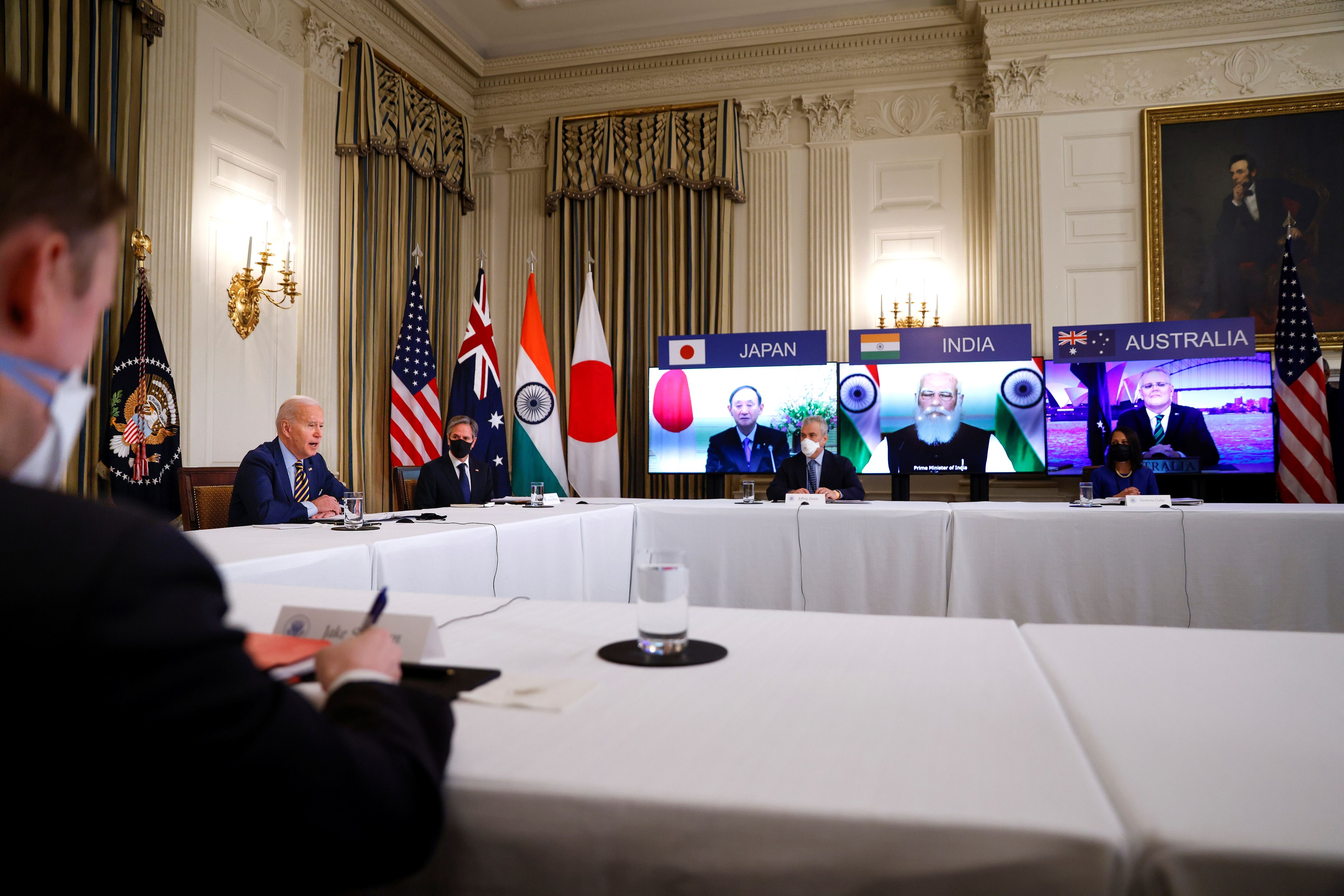The Quad Summit and New U.S. Economic Initiative - Strengthening Cooperation in the Indo-Pacific
On 24 May during a visit by U.S. President Joe Biden to Japan, a leaders summit in the Quad format, bringing together Australia, India, Japan, and the U.S, was held. A day earlier, the Indo-Pacific Economic Framework (IPEF) was announced, which, besides the Quad members, ten other countries in the region want to join. Both the summit and IPEF announcement confirm the growing U.S. engagement in the Indo-Pacific and the preparation of a broader and more attractive offer of cooperation for the region as an alternative to Chinese proposals.
_sm.jpg) POOL/Zuma Press/Forum
POOL/Zuma Press/Forum
What is the Quad?
The Quad is a cooperation formula revived during the Trump administration that involves four democratic countries in the Indo-Pacific region. Its roots go to the joint response to the 2004 tsunami in Asia and the informal dialogue that began in 2007. The Quad has become an important instrument of President Biden’s policy towards the region. From the first leaders summit in March 2021, further meetings took place in person in the U.S. in September 2021 and online in March 2022. During this time, the number of leader-level working groups was increased from three to six: on COVID-19 responses, climate, emerging technologies, space, cyber and infrastructure. The May summit was to reaffirm the group members’ determination to work together for a “free and open Indo-Pacific” that not only is inclusive but also “resilient”. The Quad is therefore promoted as a “force for good”—a forum that has a positive agenda and offers practical solutions to the problems of the countries in the region. The announcement of more regular meetings of leaders—the next summit was announced for 2023 in Australia—and of foreign ministers confirms that the forum has become an integral part of the regional institutional architecture.
What was agreed at the recent summit?
The most important outcome is the announcement of two initiatives—the Indo-Pacific Partnership for Maritime Domain Awareness (IPMDA) to improve the ability to monitor the waters of the region and counteract illegal fishing and the Quad Climate Change Adaptation and Mitigation Package (Q-CHAMP). Quad leaders announced that they will allocate $50 billion for infrastructure investments in the region within the next five years, support partners in addressing the debt burden, improve the interoperability and security of 5G technologies, cooperate in the development of a “competitive market” for semiconductors, and strengthen the protection of critical infrastructure, including in the digital sphere. They promised further support for the region in tackling health threats, including donating more COVID-19 vaccines, on top of the 265 million doses delivered so far. They also launched the Quad scholarship programme. However, with India taking a different stance than the others on Russia’s invasion of Ukraine, the leaders only generally referred to the war. They did not label Russia an aggressor and only reaffirmed their adherence to international law and respect for the sovereignty and territorial integrity of “all states”.
Did the summit decisions change the nature of Quad?
The meeting confirmed the Quad’s evolution towards a cooperation forum on economic, development, and technological issues instead of its previous focus on security matters. Thus, a division of labour has emerged between the Quad as a political grouping and AUKUS, dealing with military cooperation. The change of character of Quad is intended to show that the forum is not China-focused, and is certainly not an “Asian NATO”. In the joint statement after the summit, the leaders did not mention China even once, although many activities undertaken by the Quad are a response to Chinese activity in the region (e.g., militarisation of disputed features or unsustainable investments leading to a debt trap). The meeting ended speculation on the expansion of the group’s composition (such aspirations were signalled by, for example, South Korea). On the other hand, the leaders welcomed the EU’s Indo-Pacific Strategy, adopted in September 2021, and expressed the willingness to cooperate more closely with the Union in the region. The Quad thus emphasises openness to cooperation with all partners who share their values and vision for the region.
What is the New U.S. economic initiative?
On 23 May, before the Quad summit, President Biden, who was in Tokyo and accompanied by the leaders of 12 countries in the region (most of them virtual), launched the process of creating the IPEF. In addition to the four Quad members (the Prime Ministers of Japan and India participated personally in initiating the project), seven ASEAN countries (Brunei, Philippines, Indonesia, Malaysia, Singapore, Thailand, and Vietnam), as well as South Korea and New Zealand announced their involvement (as did Fiji after Biden’s visit to Asia). Together, these 14 countries account for around 40% of global GDP. The aim of the IPEF is to support socio-economic development and peace in the region by deepening cooperation, including by creating rules and standards in four areas: trade (including digital), supply chains (e.g., key raw materials and semiconductors), clean energy, decarbonisation and infrastructure (including technology development) as well as tax and anti-corruption. The IPEF can be seen as complementing the Quad activity both thematically and in terms of the wider scope of members. Details of the initiative, which is open to other countries in the region, will be the subject of further negotiations set to last up to a year and a half. The cooperation is to be based, among others, on flexibility, meaning that members will be able to engage in selected areas of the IPEF. This may be conducive to adjusting the arrangements to the needs of various countries.
What could be the impact of the IPEF on the regional situation?
The initiative is a political signal of the U.S. determination to engage in economic activity in the Indo-Pacific. This is a response to the expectations of the countries in the region, which, after the United States withdrew from the TPP (now CPTPP) agreement in 2017, called on it to intensify economic cooperation to support the American military presence. Advances under the IPEF would enable the U.S. to increase its influence in the region by reducing the interdependence of the Indo-Pacific countries with China and reducing their vulnerability to Chinese pressure. Significant in this context is the interest in the initiative of the majority of ASEAN members, one of China’s largest trading partners, as well as India—the more so as they are not a party to the RCEP, of which China is a member. However, Taiwan was not invited to participate in the IPEF, despite its significance, for example, in the supply of semiconductors. This may be due to the reluctance of some of the countries involved in the initiative to antagonise China. The success of the IPEF will depend on, among others, the scale of U.S. incentives (including facilitating market access), while a significant challenge will be the diversification of the level of socio-economic development of the countries, which may make it difficult to, for example, establish common standards, such as on labour rights, environmental protection, and data flows.





